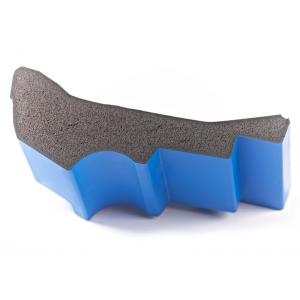
Add to Cart
Polyurethane Spare Seat Cushion for compact Fold Up Shower Seat

Introduction of Integral polyurethane skin
Integral skin, also called “self-skinning foam’’ is a microcellular core with a tough,
abrasion-resistant outer surface.
Integral skin foams come in a wide range of molded densities, and they are the perfect
solution for a broad variety of applications that require a soft touch and feel, as well as a
highly durable finish.
Fields of application
(Medical technology,Handling units,Access systems,Bank and payment
stations,Consumer electronics,Workpiece carriers)
![]()
Product Gallary

Hardness: ShoreA:20±5 Density:270±50kg/m³ Size: Customized

Why this foam?
1. Sandwich-style design with high inherent rigidity
2. Extraordinary design flexibility
3. Good thermal and acoustic insulation properties
4. Variable wall sections in a part without sink or distortion
Values not absolute some may be altered.
![]()
The Technical data is totally provided by SGS test , We accept custom
Design request.
We are very expert in manufacturing customized Integral polyurethane
skin foam parts
| Items | Test Standard | Test Result |
| Burning Performance | ISO 3795:1985 | Sweep rate<100mm²/min |
| Tensile Strength(foam part) | ISO 37:2005/Cor.1:2008 | 1.19N/㎡>1.17N/㎡ |
| Break Elongation(foam part) | ISO 37:2005/Cor.1:2008 | 197%>150% |
| Tear Resistance(foam part) | ISO 34-1:2010 Method B | 3.9N/mm |
| UV | ASTM G154-06 Cycle 1 | Gray Level:4-5 |
| Abrasive Resistance | ISO1294-2-1998+Cor.1:2002; Martindale Wear&Abrasion Tester; 12kPa | >1000 |
| CF to Rubbing | Ref.ISO 105*12-2001 | Dry stainning degree:4; Wet dyed gray:4-5 |
| Fire Resistance | ISO8191-1:1987/ISO8191-2:1988 | Conformity with flame retardancy |
| Hardness(23±2°c) | ISO868/ASTM D2240 | 50 ShoreA±5 |
| Density | ISO845 | 250±50kg/m³ |
| Surface Fire Resistance | ASTM E162 | Conformity with flame retardancy |
TIPS
Reaction Injection Molding
RIM is the result of a reaction between two liquid components isocyanate and polyol as
they are injected into a closed mould at low pressure. The two components are mixed
together as they flow into the mould as a low viscosity liquid and the reaction,
which increases the temperature and the pressure at the surface of the tool,
forms the polyurethane part in the tool cavity.